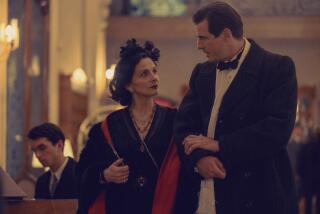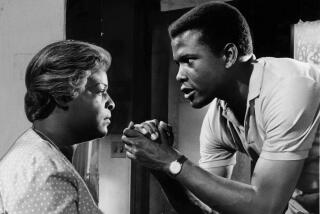Diana Mosley, 93; Nazi Sympathizer, Widow of British Fascist Party Leader
- Share via
Lady Diana Mosley, the widow of Britain’s prewar fascist party leader who was imprisoned with her husband as a Nazi sympathizer and was regarded as the most beautiful and most controversial of the famous Mitford family sisters, has died. She was 93.
Mosley, who knew Winston Churchill and Adolf Hitler, died Monday in her flat in Paris after suffering a slight stroke a week earlier. Her death, according to the notice posted by her sister, Deborah, the duchess of Devonshire, was “peaceful.”
For the record:
12:00 a.m. Aug. 16, 2003 For The Record
Los Angeles Times Saturday August 16, 2003 Home Edition Main News Part A Page 2 National Desk 1 inches; 41 words Type of Material: Correction
Mosley obituary -- An obituary of Diana Mosley, a Nazi sympathizer and the widow of Britain’s prewar fascist party leader, in Thursday’s California section misidentified a 1985 memoir she wrote as “Love Ones.” The title of the book is “Loved Ones.”
Diana Mosley was an aristocrat who became known as “the most hated woman in England” during World War II.
Her second husband, Sir Oswald Mosley, was founder of the British Union of Fascists in the 1930s, and Diana gave him her full support. She traveled to Germany frequently in the 1930s and often met with Hitler.
In 1940, the Mosleys were imprisoned as national security risks. Despite continued criticism over the years, Diana Mosley never stopped championing her husband’s political views and defending his reputation. He died in 1980.
And although she ultimately conceded that Hitler’s actions were wrong, she never expressed regret over her friendship with Hitler, a man she found “extraordinarily fascinating and clever.”
“We all know he was a monster, that he was very cruel and did terrible things,” she said in a 1994 interview. “But that doesn’t alter the fact that he was obviously an interesting figure. No torture on Earth would get me to say anything different.”
Born Diana Freeman-Mitford on June 17, 1910, she was the fourth of seven children of David Mitford, the second Baron Redesdale, and his wife, the former Sydney Bowles.
Novelist Nancy Mitford, one of Diana’s sisters, captured their sheltered and privileged upbringing -- and their eccentric relatives -- in two of her early books: “The Pursuit of Love” and “Love in a Cold Climate.”
In addition to Diana, Nancy and Deborah, the other Mitford sisters included Unity, who generated controversy in the 1930s with her own pro-Hitler views; Jessica, the author, journalist and onetime Communist Party member; and the less well-known Pamela, who married a physicist. Their brother, Tom, was killed in Burma in 1945.
By all accounts, Diana was the most beautiful of an attractive group of sisters.
Author James Lees-Milne was moved to write in his diary in the late 1920s that the tall, blond and blue-eyed Diana was “a goddess, more immaculate, more perfect, more celestial than Botticelli’s sea-born Venus.”
Novelist Evelyn Waugh, another smitten admirer, proclaimed that her beauty “ran through the room like a peal of bells.”
In 1929, at age 18, Diana married the handsome and wealthy brewing heir Bryan Guinness.
After her marriage, she became a leading London hostess whose circle of friends included society photographer Cecil Beaton, poet and author John Betjeman, painter Dora Carrington, biographer and critic Lytton Strachey and Waugh, who dedicated his novel “Vile Bodies” to her.
She had two children during her marriage to Guinness, but the union was short-lived. In 1932, she met Mosley and left her husband to live openly with the married political maverick. Mosley’s wife, Lady Cynthia Curzon, died of peritonitis in 1933.
Diana was enthralled by the older Mosley, who had recently left the Labor Party to found the British Union of Fascists. She later said she “followed him politically, absolutely blindly.” Indeed, she is said to have sat quietly in the crowd at her husband’s fascist party rallies, even when things grew volatile.
Diana visited Nazi Germany for the first time in 1933 with her sister Unity, and she first met Hitler two years later. She later affectionately recalled the Nazi leader’s “fine brown hair, chivalry and elegant hands.”
On October 1936, she and Oswald Mosley were secretly married in Nazi propaganda minister Joseph Goebbels’ drawing room in Berlin. Hitler, one of only six guests, presented the newlyweds with a photograph of himself in a heavy eagle-topped silver frame.
Diana Mosley made numerous visits to Germany over the next few years, meeting several times privately with Hitler as she handled negotiations to set up an English-speaking commercial radio station in Germany to broadcast to Britain, with profits to go to Oswald Mosley’s British Union of Fascists.
In May 1940, Oswald Mosley was interned in England’s Holloway prison. A wartime British intelligence memo urging that Diana Mosley also be imprisoned, written in 1940 and released only last year, described her as being “far cleverer and more dangerous than her husband, and will stick at nothing to achieve her ambitions.”
Diana, who was still nursing their 10-week-old second child, was imprisoned in a separate cell at Holloway a month after her husband.
Even then, in an interview with a Home Office advisory committee, she admitted that she would like to replace the British political system with the German one “because we think it has done well for that country.”
Asked if she approved of the Nazi policies against Jews, she responded, “Up to a point. I am not fond of Jews.”
Frequently mocked in the British press, she was a despised national figure.
When buses pulled up outside the prison, where she lived in a tiny cell, the conductors would call out, “This stop for Lady Mosley’s suite.”
The Mitfords were cousins of Clementine Churchill, the prime minister’s wife. And through Tom Mitford’s intervention with Winston Churchill, she was allowed to join her husband in married quarters at the prison in December 1941.
The Mosleys were released in November 1943 due to Oswald’s ill heath, but were under house arrest for the remainder of the war.
After the war, the Mosleys moved to a farm in Wiltshire. In 1948, Oswald Mosley founded the Union Movement, which promoted the idea of “Europe as a Nation,” and Diana edited the right-wing magazine The European.
They moved to France in 1951, where they became close to the duke and duchess of Windsor and where the British Embassy was forbidden to invite the Mosleys to any functions.
Known for her charm, wit and wide-ranging knowledge of literature, Mosley wrote a 1980 book about the duchess of Windsor and “Love Ones,” a 1985 memoir of her well-known friends. Her 1977 memoirs, “A Life of Contrasts,” was republished last year.
Among her survivors are her four sons, Jonathan, Desmond, Alexander and Max; and numerous grandchildren and great-grandchildren.
More to Read
Sign up for our Book Club newsletter
Get the latest news, events and more from the Los Angeles Times Book Club, and help us get L.A. reading and talking.
You may occasionally receive promotional content from the Los Angeles Times.










